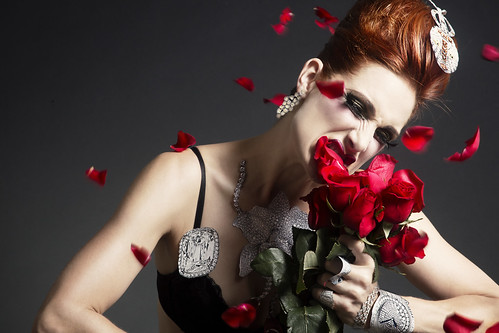When I set out to create an experience for Friday April 27th (both curating the evening and creating a performance), I knew it would be inspired by the work of Jean Paul Gaultier.
I did not know that it would lead into such a process of inquiry.
I am struck by Gaultier’s interest in difference –of shape, size, age, color and culture – which he celebrates in an irreverent but generous way. Playing with cultural costume (including counter- and queer-cultural costume), he creates a collage – layers of meaning and provocation. One of his favorite phrases is ‘Why not?’, which speaks to a spirit of inclusion.
In response, I have attempted to create a performance collage acknowledging and celebrating difference instead of any kind of ‘blindness’.
I gathered a group of people – people I like, people I wanted to get to know better, people from different places than each other, and than me. I wanted them for their skill, but also because of who they are (and am very blessed to have them together for this process).
I remembered something my ballet teacher exclaimed during class once, as praise – ‘Ah, yes, that’s it! It is the dance of our people.’ That became the title and premise for making the work. It is also my contribution to Bay Area Dance Week, a major project of organizational partner Dancers’ Group. ‘What is the dance of your people?’ I asked at the outset, and we came up with a host of answers, source material, questions, and problems with the question.
Who are my people? Do they have a dance?
What if they don’t have a dance?
What if I feel alienated from my people?
Who are my people?
What are the tensions and commonalities between our given and chosen people, families, tribes, and scenes? How do we proclaim, hide, contrast, and combine our cultural experiences and histories through self-presentation? How do we make it up?
I called the evening Making Scenes, with multiple meaning. Of course, if you put a bunch of dramatic types in a room together, drama might ensue. To make a scene is also to upset the status quo. But I am really interested in the making part. How do we create our worlds? Sometimes a ‘scene’ (pejoratively, something shallow) becomes a tribe or a family.
This resonates especially with our lecture by longtime activist and bartender Waiyde Palmer, Schooling the Children: It Came from Club Häagen-Dazs. What started out as a bunch of kids literally making a scene in their workplace, gave birth to nightclubs that many queer folk would call home and refer to as ‘church.’ This community-creation is one of the main tenets of organizational partner CounterPULSE
When telling a friend about the beginnings of ‘Our People’ he reacted with: ‘Ooooh, girl, It’s a Small World After All! United Colors of Bennetton!’ and I thought: ‘Noooo! Not clichéd togetherness!’ And then I thought: ‘Why not?’ I can’t deny the formative power of ‘It’s a Small World’ or Bennetton. When I look at them both with the critical eye of my 90s education in identity and difference, it’s easy to be cynical, but when I look deeper, I have to credit them with shaping my politics. (And deeper still, I realize that the similarities between the Gaultier exhibition and the Disney ride are uncanny.)
Just when I think that many questions about diversity and difference might be kind of tired, I realize that apparently they are not exhausted. Achieving harmony in difference is a major theme right now.
The early 90s were also the height of a vibrant and irreverent club culture that I basically missed because I was reading and arguing with my housemate in a very politicized living room about all the things that we found ‘problematic.’ These were crucial discussions to have, but they left me petrified.
When I started really going to clubs, relatively late in life, I experienced a vital culture shock. Suddenly, I found myself in the midst of a group of all kinds of folks who were irreverent, smart, powerful and free. It wasn’t that nothing was problematic, it was just that this culture seemed to value the project of seeing the problematic from all of its angles without trying to smooth all them out. This is also Gaultier’s world. From my former vantage point (early 90s politics), it is easy to find much of his work problematic. The truth is, I still do. And I love it.
Share This!
More Good Stuff
QUAKE is an upcoming solo performance at CounterPulse by Kat Gorospe Cole centered around mental health and ancestral connection. Exploring within what seedkeeper Rowen White
A little over a year ago, ABD's Artistic Director Anne Bluethenthal opened one of our weekly Skywatchers meetings by asking: Who has your back? And
Seth and Remy - Photo by Adam Paulson By Seth Eisen In 2006 after Remy Charlip had a stroke I was given the



